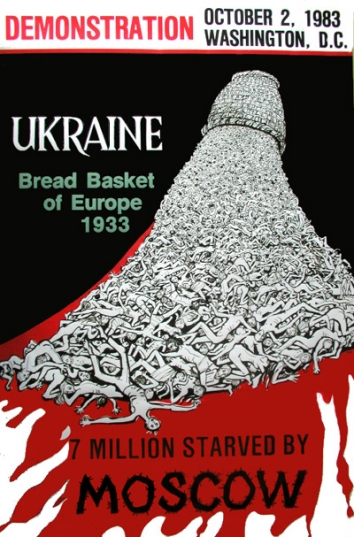Featured Galleries USUBC COLLECTION OF OVER 160 UKRAINE HISTORIC NEWS PHOTOGRAPHS 1918-1997
 Holodomor Posters
Holodomor Posters

Demand outlook strong but cost competitiveness and project execution top priorities for miners in 2013
 Ernst & Young LLC, Kyiv, Ukraine
Ernst & Young LLC, Kyiv, Ukraine
19 December, 2012
SYDNEY, 18 DECEMBER 2012 – Cost competitiveness and project execution will remain the focus for global mining and metals companies going into 2013, in stark contrast to 12 months ago when fast-tracking production was still top of the agenda.
Ernst & Young’s Global Mining & Metals Leader, Mike Elliott, says the fundamental demand outlook for the sector remains strong and with the policy-induced soft landing in China, the picture coming into 2013 is brighter.
“However the volatility created by the global economic roller-coaster over the past 12 months, and the cost blowouts in the sector from the rapid expansion in recent years has created a very different operating environment for miners coming into 2013,” says Elliott.
“The volatility has created greater risk aversion by shareholders who have increased the pressure on mining companies to deliver committed projects more efficiently and not spend capital on new projects or investments. This creates other challenges for miners looking at how they achieve longer term growth plans – they have the cash but not shareholder permission to invest.”
Elliott says in addition to cost competitiveness and project execution, key focus areas for miners globally in 2013 will be recycling capital for growth, managing local community stakeholder relationships, and balancing capital restraints with Foreign Direct Investment (FDI) obligations.
Outlook
“The fundamental demand story for mining and metals remains strong and we are already seeing an increase in growth in the Chinese economy, with expectations that this will be maintained in 2013,” says Elliott. - “While we remain confident in the outlook for demand, we are more concerned about how the current hiatus in new capital approvals will impact future supply.”
“Supply constraint issues remain the key driver for many commodities in the medium to longer term, particularly iron ore, copper and lead. There will need to be higher price signals to attract investment for new supply to meet longer term demand.”
2012 vs 2013: a very different picture
The priority for miners 12 months ago was to maximize production to capitalize on premium prices. The speed with which commodity prices softened off the back of reduced growth in demand from China and Eurozone uncertainty fuelled investor caution. This has lowered shareholders’ appetite for risk, creating a very different environment for miners to navigate coming into 2013.
Elliott says changes in the profile of shareholders in the sector have added to the pressure to adopt a more conservative approach.
“The high returns in the mining sector in recent years have attracted different investors with a different risk appetite, who are more sensitive to changes in global economic market conditions. A “traditional” mining investor would be more comfortable with the longer term horizon and returns.”
Cost competitiveness and project execution
Producing countries that experienced the impact of the rapid expansion and higher exchange rates are now dealing with a higher cost legacy. As a result, cost competitiveness and tighter discipline around project execution and operational effectiveness have become a key issue for miners globally.
“The mining sector has been very production-focused for most of the past decade and quite quickly that has changed where cost is now a much greater restraint and this is requiring a re-think in project execution. Every project has to be more cost competitive because it is the marginal projects that will be shut down first,” he says.
Capital expenditure is the single biggest area where cost inflation has impacted and therefore becomes the easiest target cost reduction.
“The companies that achieve sustainable, long term improvements in productivity and capital project execution will be best positioned to take advantage of opportunities when new capital investment returns.”
Elliott says the cost focus is also reflected in tighter sub-contractor management in the sector, with restrictions on the scope of services and a greater focus on deliverables and compliance.
Recycling capital
With less capital being committed, miners needing capital for growth will be focused on recycling existing capital by divesting non-core or underperforming assets to free up capital for investment.
“As capital investment constraints on the larger diversified miners limits the amount of new capital that can be directed to lower the operating costs of high cost mines, these mines will be more valuable to prospective buyers who are not restricted in investing new capital.”
Balancing capital restraint with FDI obligations
“Balancing Board and shareholder demands to restrict capital expenditure with meeting FDI obligations on proposed developments will be a challenge for many miners in 2013,” says Elliott.
“There will be many companies walking a tightrope around “use it or lose it” clauses in their licences, while not wanting to over-commit to new capital spending. We’ve already seen Tanzania announce a review of 300 licences on this basis.”
Community stakeholder relations
The emergence of ‘sharing the spoils’ of the resources boom as a key risk for the sector will also see a greater focus on community stakeholder relations.
“Miners are re-doubling efforts to maintain constructive relationships with local community stakeholders to avoid igniting issues that can quickly become claims to redistribute the benefits of the mine.”
“In many parts around the world – notably in Peru – what may be initially regarded as small, local issues have provided a catalyst for a broader range of claims over access to wealth generated by the mine that can destroy project value.”











